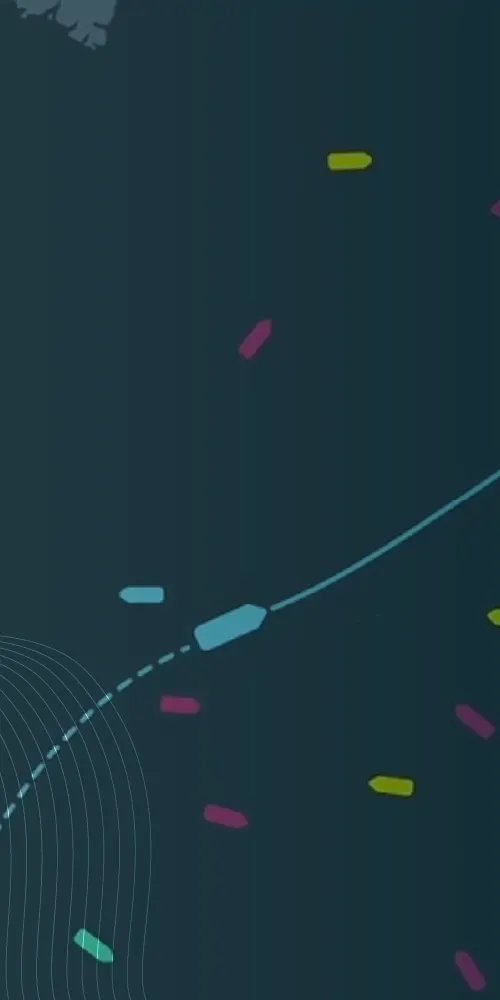Navigating challenges in modern maritime operations: A dual perspective

In the era of digitalisation, the role of ship operators has undergone a profound transformation. This fourth industrial revolution, also known as Maritime 4.0, is characterised by disruptive trends including the rise of big data, connectivity, analytics and automation. Artificial Intelligence (AI), cloud computing and the Internet of Things (IoT) are transforming traditional maritime practices into more connected, efficient, safe and sustainable processes. Adopting these tools is no longer an optional extra for a ship operator, it’s a strategic imperative for staying competitive in the evolving maritime landscape.
Next generation voyage optimisation offers:
- Improved routing strategies: Next-generation voyage optimisation provides a highly sophisticated approach to charting efficient courses aligned with company goals and evolving regulations.
- Enhanced fuel efficiency: Utilising advanced analytics and machine learning, smart voyage optimisation revolutionises the way fuel is managed in maritime operations.
- Better supply chain management: Real-time data offers ship operators end-to-end visibility, enabling adaptability in the ever-evolving landscape of modern supply chains.
- Sustainable shipping: Thanks to optimised routes and enhanced fuel efficiency, voyage optimisation contributes to a more sustainable future in maritime, benefiting both industry finances and environmental impact.

The human element
While technology enhances decision-making for shipping operators, it should always be used as a supplement and not a substitute. Voyage optimisation offers efficiency and analytics, while the human touch adds adaptability and intuitive problem-solving. This synergy results in a maritime industry that's not just technologically advanced, but also resilient, adaptable and ethically sound. However, despite the proven benefits of this human-machine interaction, navigating the vast sea of data presents its own unique new challenges. As a result, ship operators are often resistant to the digitalisation of maritime processes.
Where ship operators were traditionally focused on operational aspects, like navigation and crew management, they must now leverage sophisticated voyage optimisation tools, data analytics, and real-time monitoring systems to enhance decision-making. This requires a new skill set that includes proficiency in data interpretation and an understanding of emerging technologies. Put simply, they are no longer simply ship operators, they are now voyage optimisers.
The introduction of new technologies doesn’t just require the adoption of new tools, it needs a significant cultural shift. One of the biggest cultural barriers to embracing new tech is the generational gap, where operators are accustomed to certain procedures and sceptical about adopting new technologies. The mindset of "we know it all" or "I can use my experience" often prevails.
In addition, modern voyage optimisation methods are perceived to increase workload, rather than reduce it. Traditionally, operators observed route planning from the sidelines, but with increased connectivity, many responsibilities have changed from operating at sea to monitoring, managing and supervising systems from ashore. Researchers at the World Maritime University introduced the notion of a "net-centric" framework of operations within the shipping industry, where seafarers can get information wherever and whenever they need it. As a result, the numerous sensors, computer systems and, most importantly, people working both offshore and onshore need to work together for the safety and efficiency of the vessel and its crew.
It is often the operator's responsibility to enable this collaborative environment and ensure communication between all stakeholders.
This shift in paradigm also brings heightened scrutiny, due to clearer accountability. While operators were once challenged to find suitable KPIs, the digitalisation of optimisation facilitates a more straightforward assessment of their route planning and how well they follow those routes.
Proving value
Operators need assurance that adopting digital solutions for voyage optimisation will provide tangible benefits and a return on investment (ROI). Therefore, demonstrating the value of these solutions in terms of cost savings, efficiency improvements, and meeting environmental regulations is crucial.
The problem is, many software solutions entering the maritime market fail to align with the operators’ primary pain points. Effective solutions need a customer-centric approach, with a deep understanding of the operator's operational environment, challenges and goals. Additionally, there is often mis-communication between technology developers and maritime professionals. The technical language and jargon used by software providers may not always translate well into the operational language of the shipping industry. Bridging this gap is essential for successful collaboration and implementation.
ZeroNorth’s solution
ZeroNorth's mission is to turn data into actionable insights. Our Voyage Optimisation solution revolutionises how operators navigate maritime journeys by leveraging advanced algorithms to process millions of data points. The result? Personalised, data-driven recommendations for the safest, most cost-efficient routes.
We provide operators with a detailed overview of their entire fleet, giving them full transparency and actionable insights, which are easy to understand and share with all stakeholders. ZeroNorth does all the hard work, so you don’t have to.
Key features:
✓ Real-time weather route optimisation
✓ Compare multiple route suggestions, including the master’s route
✓ Customised vessel safety parameters & validation
✓ Advanced fuel models
✓ 24/7/365 weather service
✓ Support from master mariners and meteorologist professionals
ZeroNorth's Voyage Optimisation isn't just about managing current challenges. It's a data-driven future-proof solution, empowering ship operators to strike a balance between profitability and sustainability.